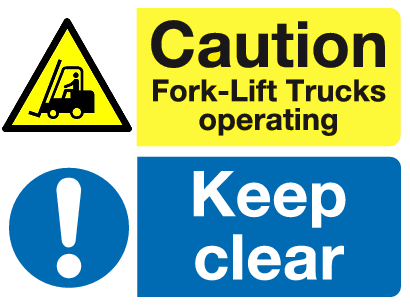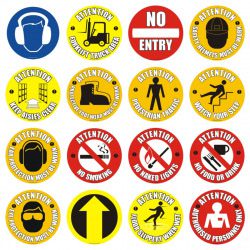Forklift Truck Safety Signs-- Advertise Safe Practices and Crash Prevention
Secret Considerations for Creating Effective Forklift Safety Indicators
When developing efficient forklift safety and security indicators, it is vital to consider several essential variables that collectively make sure ideal visibility and quality. High-contrast shades combined with big, understandable sans-serif typefaces dramatically enhance readability, particularly in high-traffic areas where quick understanding is essential. forklift signs. Strategic placement at eye degree and making use of sturdy materials like light weight aluminum or polycarbonate further contribute to the long life and effectiveness of these indications. Adherence to OSHA and ANSI standards not just systematizes safety messages however likewise strengthens conformity. To totally understand the complexities and best practices included, a number of added considerations advantage closer interest.
Color and Contrast
While developing forklift safety indicators, the option of color and comparison is extremely important to making sure visibility and effectiveness. Shades are not simply aesthetic components; they serve essential useful functions by communicating certain messages quickly and reducing the danger of mishaps. The Occupational Safety and Wellness Administration (OSHA) and the American National Criteria Institute (ANSI) offer standards for utilizing shades in security indications to systematize their definitions. For example, red is generally made use of to represent prompt danger, while yellow signifies caution.
Efficient comparison between the background and the message or signs on the sign is similarly essential (forklift signs). High contrast guarantees that the indicator is readable from a distance and in differing illumination conditions.
Using proper color and comparison not only follows regulative criteria but also plays an important role in keeping a safe functioning setting by making sure clear interaction of threats and instructions.

Typeface Size and Style
When developing forklift security indicators, the selection of font dimension and style is essential for making certain that the messages are readable and swiftly comprehended. The primary purpose is to enhance readability, particularly in atmospheres where fast details processing is important. The font style dimension ought to be big enough to be checked out from a distance, accommodating varying sight problems and making sure that personnel can understand the sign without unnecessary strain.
A sans-serif typeface is generally advised for safety and security indications as a result of its clean and uncomplicated look, which improves readability. Fonts such as Arial, Helvetica, or Verdana are commonly liked as they lack the intricate information that can cover important info. Consistency in font design throughout all safety indicators aids in developing an attire and specialist look, which better enhances the value of the messages being communicated.
Additionally, emphasis can be attained through strategic usage of bolding and capitalization. Secret words or expressions can be highlighted to draw prompt attention to crucial guidelines or cautions. Nevertheless, overuse of these techniques can result in visual clutter, so it is necessary to apply them sensibly. By thoroughly picking suitable typeface dimensions and styles, forklift security indications can efficiently communicate critical security details to all workers.
Placement and Visibility
Ensuring ideal positioning and presence of forklift safety and security signs is extremely important in industrial setups. Proper indicator positioning can substantially decrease the danger of mishaps and improve total work environment safety.

Illumination problems likewise play a vital function in exposure. Indicators need to be well-lit or made from reflective materials in poorly lit locations to guarantee they are visible whatsoever times. Making use of contrasting shades can even more boost readability, specifically in environments with varying light problems. By carefully taking into consideration these facets, one can guarantee that forklift safety indications are both efficient and noticeable, thus cultivating a much safer working environment.
Material and Toughness
Selecting the right materials for forklift security indications is essential to guaranteeing their longevity and effectiveness in industrial environments. Given the severe conditions typically come across in stockrooms and making centers, the products selected need to hold up against a selection of stress factors, consisting of temperature changes, wetness, chemical direct exposure, and physical influences. Resilient substrates such as aluminum, high-density polyethylene (HDPE), and polycarbonate are prominent selections because of their resistance to these aspects.
Light weight find this aluminum is renowned for its robustness and rust resistance, making it an excellent selection for both indoor and outside applications. HDPE, on the various other hand, provides exceptional effect resistance and can sustain prolonged exposure to severe chemicals without weakening. Polycarbonate, recognized for its high impact stamina and clarity, is typically made use of where visibility and visit longevity are vital.
Just as vital is the kind of printing used on the indicators. UV-resistant inks and protective finishings can significantly improve the lifespan of the signs by protecting against fading and wear triggered by prolonged direct exposure to sunlight and other ecological factors. Laminated or screen-printed surfaces give additional layers of security, ensuring that the important security details continues to be legible over time.
Investing in premium materials and durable manufacturing refines not only extends the life of forklift safety signs yet additionally strengthens a culture of safety within the office.
Conformity With Regulations
Sticking to regulative requirements is extremely important in the design and deployment of forklift safety and security indications. Compliance ensures that the indicators are not only effective in sharing crucial security info but additionally fulfill lawful responsibilities, thereby alleviating potential responsibilities. Different organizations, such as the Occupational Safety and Wellness Management (OSHA) in the USA, offer clear standards on the requirements of safety signs, including color design, message size, and the incorporation of universally recognized signs.
To follow these guidelines, it is necessary to perform a thorough evaluation of applicable criteria. As an example, OSHA mandates that safety and security indicators need to show up from a distance and include details colors: red for threat, yellow for caution, and green for safety and security directions. In addition, sticking to the American National Criteria Institute (ANSI) Z535 series can better enhance the effectiveness of the indications by browse around these guys standardizing the design components.
Additionally, routine audits and updates of safety indicators must be carried out to guarantee continuous conformity with any kind of adjustments in regulations. Involving with certified security experts throughout the design stage can likewise be beneficial in making certain that all regulative demands are fulfilled, and that the signs offer their intended objective successfully.
Verdict
Designing reliable forklift security signs requires mindful focus to shade contrast, font style dimension, and style to make certain optimal visibility and readability. Strategic placement at eye degree in high-traffic locations enhances recognition, while making use of resilient products ensures longevity in numerous environmental conditions. Adherence to OSHA and ANSI standards standardizes safety messages, and incorporating reflective materials boosts exposure in low-light situations. These considerations collectively contribute to a safer working setting.